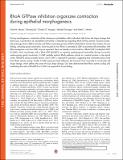| dc.contributor.author | Mason, Frank M | |
| dc.contributor.author | Xie, Shicong | |
| dc.contributor.author | Vasquez, Claudia G | |
| dc.contributor.author | Martin, Adam C | |
| dc.contributor.author | Tworoger, Michael B. | |
| dc.date.accessioned | 2017-05-02T18:15:11Z | |
| dc.date.available | 2017-05-02T18:15:11Z | |
| dc.date.issued | 2016-08 | |
| dc.date.submitted | 2016-03 | |
| dc.identifier.issn | 0021-9525 | |
| dc.identifier.issn | 1540-8140 | |
| dc.identifier.uri | http://hdl.handle.net/1721.1/108604 | |
| dc.description.abstract | During morphogenesis, contraction of the actomyosin cytoskeleton within individual cells drives cell shape changes that fold tissues. Coordination of cytoskeletal contractility is mediated by regulating RhoA GTPase activity. Guanine nucleotide exchange factors (GEFs) activate and GTPase-activating proteins (GAPs) inhibit RhoA activity. Most studies of tissue folding, including apical constriction, have focused on how RhoA is activated by GEFs to promote cell contractility, with little investigation as to how GAPs may be important. Here, we identify a critical role for a RhoA GAP, Cumberland GAP (C-GAP), which coordinates with a RhoA GEF, RhoGEF2, to organize spatiotemporal contractility during Drosophila melanogaster apical constriction. C-GAP spatially restricts RhoA pathway activity to a central position in the apical cortex. RhoGEF2 pulses precede myosin, and C-GAP is required for pulsation, suggesting that contractile pulses result from RhoA activity cycling. Finally, C-GAP expression level influences the transition from reversible to irreversible cell shape change, which defines the onset of tissue shape change. Our data demonstrate that RhoA activity cycling and modulating the ratio of RhoGEF2 to C-GAP are required for tissue folding. | en_US |
| dc.description.sponsorship | American Cancer Society (125792-RSG-14-039-01-CSM) | en_US |
| dc.language.iso | en_US | |
| dc.publisher | Rockefeller University Press, The | en_US |
| dc.relation.isversionof | http://dx.doi.org/10.1083/jcb.201603077 | en_US |
| dc.rights | Creative Commons Attribution-Noncommercial-Share Alike 3.0 Unported license | en_US |
| dc.rights.uri | http://creativecommons.org/licenses/by-nc-sa/3.0/ | en_US |
| dc.source | Rockefeller University Press | en_US |
| dc.title | RhoA GTPase inhibition organizes contraction during epithelial morphogenesis | en_US |
| dc.type | Article | en_US |
| dc.identifier.citation | Mason, Frank M.; Xie, Shicong; Vasquez, Claudia G.; Tworoger, Michael and Martin, Adam C. “RhoA GTPase Inhibition Organizes Contraction During Epithelial Morphogenesis.” The Journal of Cell Biology 214, no. 5 (August 2016): 603–617. © 2016 Mason et al. | en_US |
| dc.contributor.department | Massachusetts Institute of Technology. Computational and Systems Biology Program | en_US |
| dc.contributor.department | Massachusetts Institute of Technology. Department of Biology | en_US |
| dc.contributor.mitauthor | Mason, Frank M | |
| dc.contributor.mitauthor | Xie, Shicong | |
| dc.contributor.mitauthor | Vasquez, Claudia G | |
| dc.contributor.mitauthor | Tworoger, Michael B | |
| dc.contributor.mitauthor | Martin, Adam C | |
| dc.relation.journal | Journal of Cell Biology | en_US |
| dc.eprint.version | Final published version | en_US |
| dc.type.uri | http://purl.org/eprint/type/JournalArticle | en_US |
| eprint.status | http://purl.org/eprint/status/PeerReviewed | en_US |
| dspace.orderedauthors | Mason, Frank M.; Xie, Shicong; Vasquez, Claudia G.; Tworoger, Michael; Martin, Adam C. | en_US |
| dspace.embargo.terms | N | en_US |
| dc.identifier.orcid | https://orcid.org/0000-0003-1338-494X | |
| dc.identifier.orcid | https://orcid.org/0000-0002-3283-3248 | |
| dc.identifier.orcid | https://orcid.org/0000-0002-8987-7508 | |
| dc.identifier.orcid | https://orcid.org/0000-0001-8060-2607 | |
| mit.license | PUBLISHER_CC | en_US |
| mit.metadata.status | Complete | |
